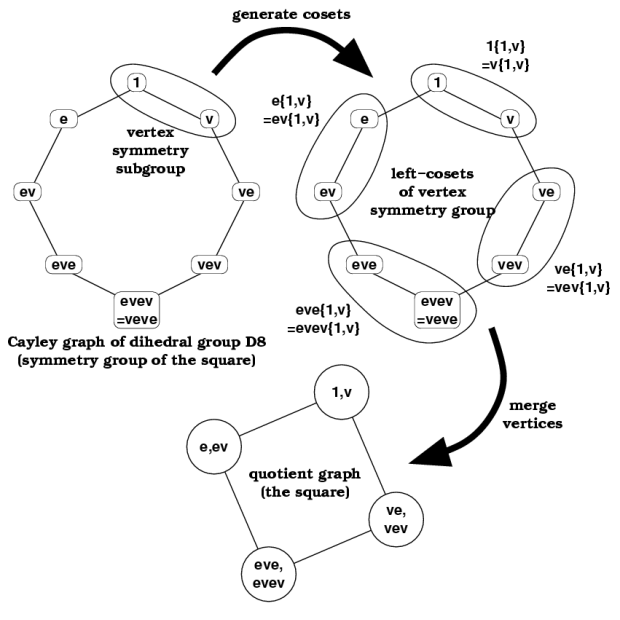Dynkin diagrams are a convenient way of representing Coxeter matrices, and are drawn as follows:
- draw a circle for each generator ri.
- for each pair of generators ri,rj, draw |ri,rj|-2 lines between the corresponding circles. (If there are too many lines to draw, simply draw one line labelled by the order |ri,rj|.)
- If the dynkin diagram of a group consists of k connected components D1,...,Dk, then the Coxeter group is the direct product of the Coxeter groups defined by each component Di, as in the 6x8 torus "
 ".
".
- In particular, lone circles represent factors of the two-element group Z/2, as in
"
 ".
".
The polytopes in the catalog are all quotients of the Cayley graph of a Coxeter group (by the vertex symmetry subgroup). For example,
- The "free" polytopes in the Coxeter group section are quotients WRT the trivial group, e.g. "
 ".
".
- The vertices of regular polygons, polyhedra, and polychora are cosets of the symmetry group with respect the subgroup generated by all-but-one of the symmetry group generators, e.g. "
 " for the pentagon, "
" for the pentagon, " " for the dodecahderon, and "
" for the dodecahderon, and " " for the 120-cell.
" for the 120-cell.
- The tori/duoprisms are direct products of regular polygons, e.g. "
 ".
".
- The lattice of quotients of H4 (the symmetry group of the 120-cell) mirrors exactly the lattice of subsets of its set of four generators, each subset generating a vertex symmetry group.
- In particular, the polytope whose vertex-symmetry group is the entire polytope symmetry group ("
 "at the top of the H4 lattice) is the degenerate 1-cell.
"at the top of the H4 lattice) is the degenerate 1-cell.
Extended Dynkin diagrams are a convenient way of representing polytopes, and are drawn as follows:
- find a presentation of the polytope's symmetry group as a Coxeter group.
- draw the Dynkin diagram of the symmetry group.
- find the vertex symmetry subgroup of the coxeter group, as generated by some subset of generators of the larger group.
- draw a dot in the center of each circle which is also a generator of the vertex symmetry group.
Note that " " and "
" and " " are considered the same diagram.
" are considered the same diagram.
Note that the extended Dynkin diagram symbol of a polytope is not always unique, e.g. the 6x8 torus can be variously denoted by
" ",
"
",
" ",
"
",
" ", or
"
", or
" ".
".
Exercise: What are all the extended Dynkin diagrams of the hypercube? (Hint: consult the catalog for some examples.)
Technically the vertex symmetry subgroup induces an equivalence relation on vertices of the (right-)Cayley graph, which induces a graph homomorphism from the Cayley graph down to a "quotient" graph.
Example: The symmetry group of the square is the 8-element dihedral group G = D8 = " " with Cayley graph the octagon, say generated by a pair of reflections v,e (refer to Figure 1 below).
The vertex symmetry group of the square is the two-element reflection group {1,v} about a vertex, generated by v.
The (left-)cosets of this set, namely {g{1,v} | g in G} define an equivalence relation on vertices of the Cayley graph.
Identifying/merging all Cayley graph vertices in each class results in the quotient graph --the square, i.e., "
" with Cayley graph the octagon, say generated by a pair of reflections v,e (refer to Figure 1 below).
The vertex symmetry group of the square is the two-element reflection group {1,v} about a vertex, generated by v.
The (left-)cosets of this set, namely {g{1,v} | g in G} define an equivalence relation on vertices of the Cayley graph.
Identifying/merging all Cayley graph vertices in each class results in the quotient graph --the square, i.e., " ".
".

Figure 1. Constructing a quotient graph "
 " from the Cayley graph of its symmetry group "
" from the Cayley graph of its symmetry group " ".
".
- Dynkin diagrams are employed, e.g., in Conway's Atlas of Finte Groups.
- Also see Mathworld's explanation.